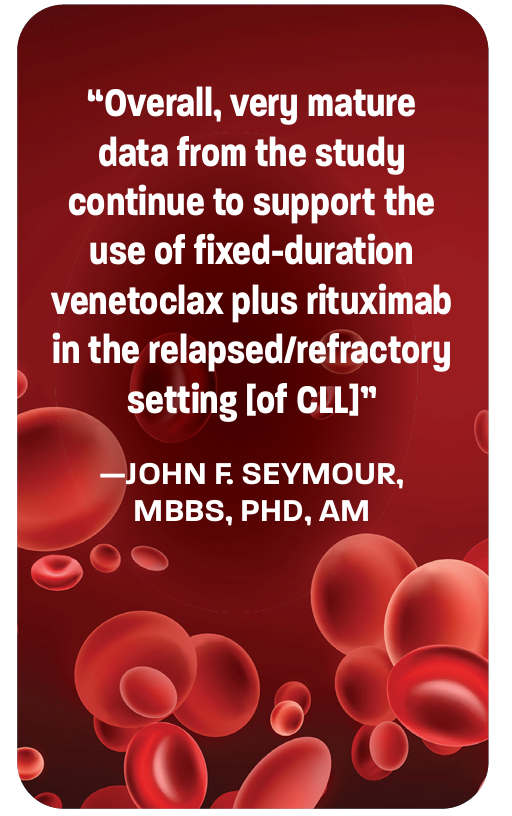Survival Benefit Continues With Fixed-Duration Venetoclax in CLL
In the phase 3 MURANO trial, there was a continued survival benefit in patients with chronic lymphocytic leukemia treated with fixed-duration venetoclax plus rituximab.
John F. Seymour, MBBS, PhD, AM
Clinical Haematologist
Director
Department of Haematology
Peter MacCallum Cancer Centre & the Royal Melbourne Hospital
Melbourne, Australia

Findings from the phase 3 MURANO trial (NCT02005471) demonstrated continued survival benefit for patients with chronic lymphocytic leukemia (CLL) treated with fixed-duration venetoclax (Venclexta) plus rituximab (Rituxan) compared with bendamustine (Bendeka) plus rituximab. A substudy that evaluated the benefit of retreatment or crossover also revealed similar positive outcomes for overall response rate (ORR) and undetectable minimal residual disease (uMRD). Investigators also noted that uMRD was associated with prolonged progression-free survival (PFS) in patients given venetoclax plus rituximab.1 Results were presented at the 2023 International Workshop on CLL.1
At the final data cutoff of August 3, 2022, 7-year follow-up data demonstrated that patients who received venetoclax plus rituximab (n = 194) achieved a median PFS of 54.7 months (95% CI, 52.3-59.9) compared with 17.0 months (95% CI, 15.5-21.7) in the bendamustine plus rituximab arm (n = 195; HR, 0.23; 95% CI, 0.18-0.29; stratified P < .0001); the 7-year PFS rates were 23% vs not evaluable (NE), respectively. The median OS was NE in the venetoclax plus rituximab arm compared with 87.8 months (95% CI, 70.1-NE) in the bendamustine arm (HR, 0.53; 95% CI, 0.37-0.74; stratified P < .0002); the 7-year OS rates were 69.6% vs 51.0%, respectively. The median follow-ups for efficacy in the venetoclax and bendamustine arms were 86.8 months (range, 0.3-99.2) and 84.4 months (range, 0.0-95.0), respectively.
“The PFS and OS benefits for a 2-year fixed-duration venetoclax [plus] rituximab treatment [regimen] were sustained at the 7-year follow-up compared with what was previously standard chemoimmunotherapy,” John F. Seymour, MBBS, PhD, AM, a clinical hematologist and the director of the Department of Hematology at the Peter MacCallum Cancer Centre and the Royal Melbourne Hospital in Australia, said during the presentation. “Achievement of uMRD remains associated with prolonged PFS in patients receiving time-limited venetoclax. Retreatment [with venetoclax plus rituximab] is a viable option for patients with PD [progressive disease] and achieves a median PFS approaching 2 years. Overall, very mature data from the study continue to support using fixed-duration venetoclax plus rituximab in the relapsed/refractory setting [of CLL].”

Findings from the substudy that evaluated patients with PD who received venetoclax plus rituximab as either retreatment or as crossover treatment from the bendamustine arm showed that patients receiving retreatment (n = 25) achieved a median PFS of 23.3 months (95% CI, 15.6-24.3). The best ORR was 72%, including a 24% complete response rate, and the median OS was not reached. Eight patients achieved uMRD status at the end of retreatment with venetoclax plus rituximab, although none retained uMRD at the end of treatment.
In the substudy, most patients were classified as having high-risk disease at baseline. Among patients who were retreated with the venetoclax-containing combination, the median age was 66 years (range, 49-82). Most patients underwent 2 prior lines of therapy (80%), with 16% receiving 3 prior therapies and 1 patient having been given at least 4 prior treatments. Most patients did not have TP53 (68%) or IGHV mutations (88%). The median follow-up was 33.4 months (range, 2.7-44.0) and the median time from final study drug dose in the main study to retreatment in the substudy was 2.3 years (range, 1.2-3.1).
MURANO was a global, open-label trial that enrolled patients with relapsed/ refractory CLL who received 1 to 3 prior lines of therapy, including at least 1 standard chemotherapy-containing regimen, and an ECOG performance status of 1 or less.2 Patients were stratified by del(17p) status, responsiveness to prior therapy, and geographic region. Peripheral blood MRD was measured by allele-specific oligonucleotide polymerase chain reaction and/or flow cytometry (< 10-4 threshold for uMRD).1
Eligible patients were randomly assigned to rituximab at a dose of 375 mg/m2 on day 1 of cycle 1, then at 500 mg/m2 on day 1 of cycles 2 through 6 in combination with either oral venetoclax 400 mg once daily or bendamustine 70 mg/m2 on days 1 and 2 of cycles 1 through 6. Following cycle 6, patients in the investigational arm were then treated with venetoclax monotherapy at the same dosing schedule for up to 2 years from the first dose received. Before the start of combination treatment, patients in the investigational arm also received 5-week ramp-up doses of venetoclax starting at 20 mg going up to 400 mg.
The coprimary end points were PFS and PD. Secondary end points included best ORR, OS, event-free survival, duration of response, and MRD negativity rate, among others.2 The baseline patient characteristics were well balanced between the 2 arms; the median age was 64.5 years (range, 28-83) compared with 66 years (range, 22-85) in the venetoclax and bendamustine arms, respectively. Most patients in both arms were men (70.1% vs 77.4%), had an ECOG performance status of 0 (57.2% vs 55.7%), and were deemed to be at medium risk of tumor lysis syndrome (54.6% vs 53.3%).3 Additional findings from the primary study showed that the time to next antileukemic treatment was 63 months (95% CI, 56.1-73.6) vs 24 months (95% CI, 20.7-29.5) in the venetoclax and bendamustine arms, respectively. Patients received subsequent antileukemic treatment at rates of 49.0% and 67.2%, respectively.1 Among patients who completed 2 years of venetoclax treatment without PD (n = 118), 83 achieved uMRD, 23 were deemed to be low MRD positive, and 12 were high MRD positive. Fourteen patients achieved sustained uMRD, defined as uMRD lasting beyond the end of treatment. Investigators noted that favorable baseline characteristics were overrepresented among patients who had lasting uMRD. Those with sustained uMRD (n = 14) vs no sustained uMRD (n = 180) had wild-type (9.0% vs 91.0%) or mutated (2.1% vs 97.9%) TP53 status, mutated (13.2% vs 86.8%) or unmutated (4.9% vs 95.1%) IGHV status, and did not have genomic complexity (5.7% vs 94.3%) or had genomic complexity (8.3% vs 91.7%), respectively.
“Importantly, there were 14 patients who remained with uMRD at 7 years after commencing treatment,” Seymour said. “Of patients with favorable disease biology—mutated IGHV and an absence of TP53 mutations—that’s a 16% frequency of very sustained uMRD in that cohort.”
Patients who achieved uMRD had a median PFS of 52.5 months (95% CI, 44.5-61.5) compared with 29.3 months (95% CI, 20.2-37.5) in the low MRD-positive group (HR, 3.46; 95% CI, 1.75-6.86; P < .0001) and 4.6 months (95% CI, 2.8-8.3) in the high MRD-positive group (HR, 17.22; 95% CI, 5.70-52.00; P < .0001). The median OS in the uMRD group was NE (95% CI, NE-NE) compared with NE (95% CI, 62.7-NE) in the low MRD-positive group (HR, 1.07; 95% CI, 0.34-3.35) and 63.1 months (95% CI, 51.5-NE) in the high MRD-positive group (HR, 2.39; 95% CI, 0.73-7.80).
In terms of safety, study authors noted that there were no new safety signals reported since the 5-year data cutoff, with all patients being outside of the reporting window for adverse effects.
REFERENCES
1. Seymour JF, Kater AP, Harrup, et al. Final 7-year follow up and retreatment substudy analysis of MURANO: venetoclax-rituximab-treated patients with relapsed/refractory chronic lymphocytic leukemia. Presented at: 2023 International Workshop on CLL; October 6-9, 2023; Boston, MA. Abstract 1550119.
2. A study to evaluate the benefi t of venetoclax plus rituximab compared with bendamustine plus rituximab in participants with relapsed or refractory chronic lymphocytic leukemia (CLL) (MURANO). ClinicalTrials.gov. Updated September 30, 2022. Accessed October 8, 2023. h ps:// www.clinicaltrials.gov/study/NCT02005471
3. Seymour JF, Kipps TJ, Eichhorst B, et al. Venetoclax-rituximab in relapsed or refractory chronic lymphocytic leukemia. N Engl J Med. 2018;378(12):1107-1120. doi:10.1056/ NEJMoa1713976

Advances in Subsequent Therapies Shake Up Sequencing of ccRCC Treatment
April 25th 2024With the approval of belzutifan and other newer data for treating patients with recurrent renal cell carcinoma, the state of subsequent therapies is advancing beyond the reuse of frontline options with impacts on duration of response and quality of life.
Read More
Ornstein Advises on Starting Dose and Management of Lenvatinib in RCC
April 21st 2024During a Case-Based Roundtable® event, Moshe Ornstein, MD, MA, provided guidance on dosing and toxicity concerns in a patient treated with lenvatinib plus pembrolizumab for advanced renal cell carcinoma.
Read More